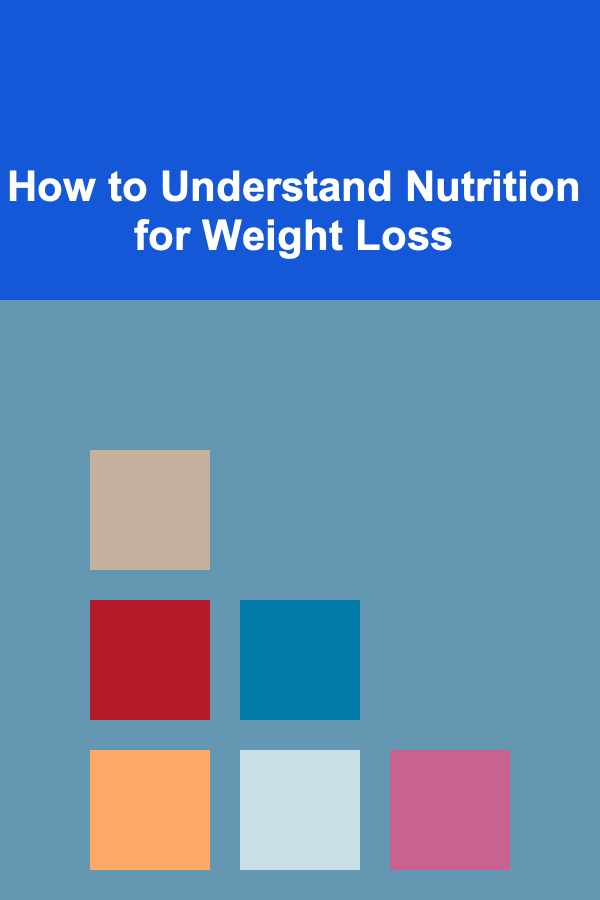
How to Understand Nutrition for Weight Loss
ebook include PDF & Audio bundle (Micro Guide)
$12.99$5.99
Limited Time Offer! Order within the next:

Nutrition is the cornerstone of any successful weight loss journey. The right approach to nutrition can help you achieve your desired body weight, maintain a healthy lifestyle, and sustain long-term wellness. However, with so much conflicting information available, understanding how to effectively use nutrition for weight loss can be overwhelming. In this article, we will explore the principles of nutrition, how different macronutrients impact your body, and how to structure your diet for sustainable weight loss.
The Fundamentals of Weight Loss
Before diving into the specifics of nutrition, it's important to understand the basic principle behind weight loss: caloric deficit. A caloric deficit occurs when you consume fewer calories than your body needs to maintain its current weight. This leads to the body using stored fat as a source of energy, resulting in weight loss over time.
However, while this principle is simple, achieving and maintaining a caloric deficit can be more complex than simply eating less. Nutrition plays a key role in not only creating this deficit but also in supporting overall health, boosting metabolism, and ensuring that the weight lost is primarily fat, rather than muscle mass.
Macronutrients: The Building Blocks of Nutrition
The three primary macronutrients---carbohydrates , proteins , and fats---are essential for providing energy and supporting various bodily functions. Understanding how each macronutrient impacts weight loss can help you make better food choices and create a balanced, effective diet plan.
Carbohydrates
Carbohydrates are the body's primary source of energy, and they come in two main types: simple and complex carbohydrates.
- Simple carbohydrates are found in foods like sugar, soda, and candy. They are quickly broken down by the body and cause rapid spikes in blood sugar, leading to energy crashes and increased hunger. For weight loss, it's best to limit simple carbohydrates, as they can encourage overeating and lead to fat storage.
- Complex carbohydrates are found in whole grains, legumes, and vegetables. These take longer to digest and provide a steady release of energy, keeping you fuller for longer. Foods rich in complex carbohydrates are nutrient-dense and typically lower in calories compared to their simple counterparts, making them ideal for weight loss.
Although carbohydrates often get a bad reputation in weight loss diets, they are an essential part of a balanced diet. The key is to focus on whole, unprocessed sources of carbohydrates and avoid refined sugars and processed grains, which can contribute to fat gain.
Proteins
Protein is often considered the most important macronutrient for weight loss. Not only does it help in building and repairing muscles, but it also plays a crucial role in satiety---the feeling of fullness after eating. Eating enough protein can help reduce overall calorie intake by curbing hunger and promoting fat loss rather than muscle loss.
- High-protein foods include lean meats (chicken, turkey), fish, eggs, dairy products, legumes, and plant-based proteins like tofu and tempeh. Protein can also boost metabolism, as it requires more energy for digestion and absorption compared to fats and carbohydrates. This thermic effect of food (TEF) can slightly increase the number of calories your body burns each day.
- How much protein do you need? For weight loss, aim to consume about 0.6 to 1 gram of protein per pound of body weight. For example, if you weigh 150 pounds, you should aim for 90-150 grams of protein per day.
Fats
Fats are another essential macronutrient that is often misunderstood. Despite being calorie-dense, healthy fats can help in weight loss by keeping you feeling full and satisfied. Fats also play a vital role in hormone regulation and absorption of fat-soluble vitamins (A, D, E, and K).
-
Healthy fats can be found in foods like avocados, olive oil, nuts, seeds, and fatty fish such as salmon. These fats are rich in monounsaturated and polyunsaturated fatty acids, which have been shown to support weight loss and improve heart health.
-
On the other hand, trans fats and saturated fats (found in processed and fried foods, and high-fat dairy) should be limited, as they can contribute to weight gain and increase the risk of cardiovascular disease.
Although fats are calorie-dense (9 calories per gram compared to 4 calories per gram for carbs and proteins), they are crucial for maintaining a balanced diet and supporting overall health. Including moderate amounts of healthy fats can help keep your body functioning optimally during weight loss.
The Role of Fiber
Fiber is a type of carbohydrate that your body cannot digest. It plays a key role in digestive health, and it also helps control blood sugar levels and manage weight. Fiber-rich foods tend to be low in calories but high in volume, which means they can help you feel full for longer without consuming excessive calories.
- Soluble fiber (found in oats, beans, and certain fruits) absorbs water and forms a gel-like substance, slowing digestion and helping to control appetite.
- Insoluble fiber (found in whole grains, vegetables, and seeds) adds bulk to stool and aids in regular bowel movements.
A high-fiber diet can help reduce calorie intake by promoting satiety and reducing the likelihood of overeating. Aim to consume 25-35 grams of fiber per day from whole foods, including fruits, vegetables, legumes, and whole grains.
Portion Control and Mindful Eating
Understanding how much to eat is just as important as understanding what to eat. Even if you choose nutrient-dense foods, consuming large portions can still lead to a caloric surplus and hinder weight loss.
The Importance of Portion Control
Portion control involves eating the right amounts of food to maintain a calorie deficit while ensuring you get the right nutrients. Here are some strategies for practicing portion control:
- Use smaller plates: Studies have shown that people tend to eat more when they use larger plates. Using smaller plates can help reduce portion sizes naturally.
- Read food labels: Pay attention to serving sizes on food labels, especially for packaged foods. Many packaged items contain more than one serving per package, and it's easy to consume more calories than you realize.
- Control liquid calories: Beverages like soda, alcohol, and sugary coffee drinks can add up quickly in terms of calories. Drinking water, herbal tea, or black coffee is a much better option for weight loss.
- Avoid distractions while eating: Eating while distracted (such as watching TV or scrolling through your phone) can lead to overeating. Instead, try to focus on your food, chew slowly, and listen to your body's hunger cues.
Mindful Eating
Mindful eating is a practice that involves paying full attention to the experience of eating, including the taste, texture, and aroma of food. By eating mindfully, you can become more in tune with your body's hunger and fullness signals, preventing overeating and emotional eating. Here are a few tips for mindful eating:
- Eat slowly: Take your time to chew your food and savor each bite. This gives your brain time to register fullness, helping you avoid overeating.
- Engage all your senses: Focus on the color, smell, and texture of your food. The more engaged you are with the eating experience, the less likely you are to mindlessly overeat.
- Listen to your body: Stop eating when you feel comfortably full, not when you're stuffed. Recognizing when you're satisfied rather than overly full is crucial for maintaining a healthy weight.
Hydration and Weight Loss
Water plays a significant role in weight loss, even though it doesn't contain any calories. Staying hydrated supports digestion, metabolism, and overall bodily functions. Sometimes, thirst is mistaken for hunger, leading to overeating. Drinking water before meals can help curb appetite and prevent unnecessary snacking.
Aim to drink 8-10 cups of water per day, or more if you're physically active or live in a hot climate. You can also include hydrating foods like cucumbers, watermelon, and celery in your diet.
Creating a Sustainable Weight Loss Plan
When it comes to weight loss, the key is sustainability. A drastic diet that cuts out entire food groups or restricts calories too severely is often not sustainable and can lead to nutrient deficiencies. A well-balanced, nutritious diet that includes a variety of whole foods will support long-term success.
Focus on Whole, Nutrient-Dense Foods
Whole foods---such as vegetables, fruits, lean proteins, whole grains, and healthy fats---are naturally lower in calories and higher in nutrients compared to processed foods. These foods provide your body with the vitamins, minerals, and antioxidants it needs to function optimally while helping you stay full and satisfied.
Incorporate Flexibility
A successful weight loss plan should include room for flexibility. While consistency is important, it's also essential to allow yourself occasional indulgences without feeling guilty. Restricting certain foods entirely can lead to feelings of deprivation, which often results in overeating later on.
Exercise and Physical Activity
While nutrition is a significant factor in weight loss, combining it with regular exercise can enhance results. Exercise helps to burn additional calories, maintain lean muscle mass, and improve overall health. A combination of strength training and cardiovascular exercise is the most effective way to lose fat and build a healthy, sustainable body composition.
Conclusion
Understanding nutrition for weight loss requires knowledge, strategy, and consistency. By focusing on whole, nutrient-dense foods, controlling portion sizes, practicing mindful eating, and staying hydrated, you can create a diet plan that supports sustainable weight loss and improves overall health. While there's no one-size-fits-all approach, making small, gradual changes to your eating habits can lead to lasting results. Embrace the process, stay patient, and always prioritize your health over rapid, unsustainable results.

How to Set Up a Functional Outdoor Fitness Space
Read More
The Pros and Cons of One-Page Websites: Is It Right for You?
Read More
What Are the Essentials for an Organized Home Office Desk?
Read More
Blind Wine Tasting: A Fun and Engaging Guide
Read More
10 Tips for Choosing the Right Paper for Printable Invitations
Read More
10 Tips Checklist for Writing Effective Grant Proposals
Read MoreOther Products

How to Set Up a Functional Outdoor Fitness Space
Read More
The Pros and Cons of One-Page Websites: Is It Right for You?
Read More
What Are the Essentials for an Organized Home Office Desk?
Read More
Blind Wine Tasting: A Fun and Engaging Guide
Read More
10 Tips for Choosing the Right Paper for Printable Invitations
Read More